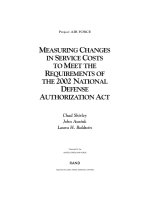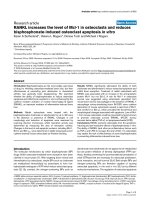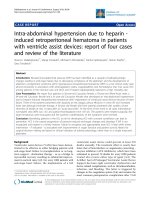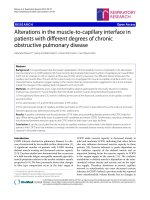Haemato-biochemical alterations in sheep due to experimentally induced Haemonchus contortus infection
Bạn đang xem bản rút gọn của tài liệu. Xem và tải ngay bản đầy đủ của tài liệu tại đây (165.35 KB, 6 trang )
Int.J.Curr.Microbiol.App.Sci (2019) 8(5): 2371-2376
International Journal of Current Microbiology and Applied Sciences
ISSN: 2319-7706 Volume 8 Number 05 (2019)
Journal homepage:
Original Research Article
/>
Haemato-biochemical Alterations in Sheep Due to Experimentally Induced
Haemonchus contortus Infection
Dipali Parmar*, Dinesh Chandra, Arvind Prasad, Ekta Singh,
Navneet Kaur* and Abdul Nasir
Division of Parasitology, ICAR-Indian Veterinary Research Institute,
Izatnagar, Uttar Pradesh, India
*Corresponding author
ABSTRACT
Keywords
Haematobiochemical, Sheep,
Haemonchous
contortus
Article Info
Accepted:
18 April 2019
Available Online:
10 May 2019
Among all the gastrointestinal nematodes belonging to family Trichostrongylidae,
Haemonchus contortus is the most prevalent and highly pathogenic nematode causing
severe loss to small ruminant production system. Parasite causes alterations in various
physiological parameters with disturbances in haemato-biochemical blood profile.
Experiment was conducted in eighteen (n=18) non-descript sheep that were randomly
divided into two groups, infected (Group-A) and (Group-B) the negative control. Group- A
animals were infected with 10,000 L3 of H.contortus. Larvae for the infective dose were
obtained through coproculture of faeces of previously infected sheep. Animals were stall
fed and were maintained separately in the animal shed to prevent infection.
Haematological (Hb, PCV, TLC, DLC) and biochemical parameters (Total protein,
albumin, globulin) were monitored at weekly intervals in both the groups. Results of the
present study concluded that infection with H.contortus led to disturbance in haemopoietic
system that led to alterations in blood haemo-biochemical profile. Mean Hb level in case
of infected group (Group-A) declined from 10.83±0.59 to 4.97±0.83 at 5th week post
infection (PI). Similarly, PCV dropped from 24.08±0.59 to 14.52±1.90. Mean Hb and PCV
values for negative control (Group-B) remained within normal range i.e. 11.07 ±0.21 and
30.99±0.83. Leucocyte count started declining from third week PI in Group-A. By 28 days
PI neutrophila and eosinophilia was observed in Group-A. Decline in albumin levels was
more pronounced in infected group and reached up to 2.54±0.13g/dl at 3rd week post
infection. No changes were observed in serum albumin levels throughout experiment in
negative control group. Albumin to globulin ratio decreased significantly in group A on
3rd, 4th and 5th week post infection as compared to negative control group.
Introduction
Sheep and goat farming is a major source of
income in developed and developing
countries. According to the Food and
Agriculture Organisation (FAO, 2013) overall
sheep population for the year 2012 was 1.2
billion worldwide, dominated by Asia
(44.9%), then Africa (27.6%) and followed by
America (7.3%). Majority of farm animals are
infected
with
several
species
of
gastrointestinal (GI) nematodes that evolved
2371
Int.J.Curr.Microbiol.App.Sci (2019) 8(5): 2371-2376
from their free living forms due to lack of
oxygen (Suntherland and Scott, 2010).
Among these, Haemonchus contortus,
Trichostrongylus colubriformis are highly
evolved and are major production limiting
infection in sheep and goat.
Disease occurrence is more common in
tropical and subtropical countries due to hot
and humid climatic conditions (Urquhart et
al., 1996). Haemonchosis can occur in all age
groups. However, animals between 2-24
months are more susceptible. Main
pathogenic effects are caused by late larval
stages and adult worms (Taylor et al., 2007;
Bowman, 2014) which attach themselves to
abomasal mucosa and feed upon blood
leading to an average blood loss of 0.05-0.07
ml/parasite (Malviya et al., 1979; Soulsby,
1982). Haemonchus is among the most fecund
strongly lid nematodes with a pre patent
period of 18-21 days. Clinical haemonchosis
is mainly classified into three types depending
upon intensity of worm burden that is
hyperacute, acute and chronic form (Soulsby,
1982; Taylor et al., 2007). Acute
haemonchosis is most common in India and is
characterised by anaemia, hypoprotenemia
and development of bottle jaw condition
(Soulsby, 1982).
Main economic losses are due to reduced
weight gain and prolonged emaciation
because of impaired digestion and decreased
absorption of protein, calcium and
phosphorus (Sood, 1981). About 30-40%
mortality has been reported in lambs due to
haemonchosis if no timely treatment with
proper anthelmintic is undertaken (Kalita et
al., 1978).
Materials and Methods
Study area and location
Present study was conducted from January
2018 to June 2018 under the project, Network
programme on gastrointestinal parasitism at
Division of Parasitology, Indian Veterinary
Research Institute, Izatnagar, Uttar Pradesh,
India on local indigenous sheep procured
from nearby village at Bareilly. The flock was
located in the subtropical region of India at
28°23’34.8ºN 79°25’59.9ºE.
Experimental sheep flock
Experiment was conducted on eighteen
(n=18) non-descript, indigenous sheep with
age less than one year. Deworming was done
with Levamisole @7.5mg/kg body and
Fenbendazole @5mg/kg body weight before
start of the experiment to clear up any preexisting parasitic infection. To check
concurrent infection with coccidia, all animals
were treated with Amprolium @ 1g/20kg
body weight for five consecutive days. Before
start of the experiment, Faecal Egg Count
(FEC) was zero for all animals.
Coproculture for infective larvae of H.
contortus
Fresh faeces from sheep infected with
H.contortus (donor animals) were collected
and pooled. Coproculture was performed on
the collected faeces as per standard technique
to harvest fresh L3 larvae (Anon, 1971) which
were identified microscopically for H.
contortus utilizing morphological key
(Levine, 1961). Sheep of group A were
infected with 10,000 H.contortus larvae given
per os. Control animals of Group B were kept
infection free.
Haemato-biochemical examination
Blood samples were collected from all the
experimental sheep both infected and control
at weekly interval from day 0 to 35 days PI.
The haemoglobin concentration (Hb%),
Packed Cell Volume (PCV), Total Leukocyte
Count (TLC), Differential Leukocyte Count
2372
Int.J.Curr.Microbiol.App.Sci (2019) 8(5): 2371-2376
(DLC) were determined. Biochemical
parameters included total serum protein,
serum albumin, serum globulin and
albumin/globulin ratio utilizing commercially
available kits.
Clinical observations
Following experimental infection, all animals
were monitored regularly for development of
clinical signs of haemonchosis, if any. During
the course of experiment, infected sheep were
observed for development of change in the
colour of eye conjunctiva, bottle jaw, body
condition, body weight gain and constipation
etc which are indicative of haemonchosis.
Results and Discussion
Coprological examination
Following infection, eggs appeared in the
faeces from 17-21 DI (Pre patent period) in
animals of infected Group A. All the animals
of infected group were positive for eggs of H.
contortus by 21 days PI. However, eggs were
absent in the control animals (Group-B)
throughout the experiment.
Haematological parameters
Significant differences in haematological
values among both groups were observed
which is presented in Table 1. At third week
post infection (PI), there was slight reduction
in Hb and PCV level in the infected group.
Thereafter a sharp decline in Hb and PCV
level was observed in infected group till end of
the experiment. Mean Hb level in case of
infected group (Group-A) declined from
10.83±0.59 to 4.97±0.83 respectively at 5th
week post infection. Similarly, PCV dropped
from 24.08±0.59 to 14.52±1.90. Mean Hb and
PCV values for negative control (Group-B)
remained within normal range i.e. 11.07 ±0.21
and 30.99±0.83 as compared to infected group.
Statistically significant difference (p<0.05)
was found in RBC count on 4th and 5th week
post challenge. Total leukocyte count was
highest in Group-A on second week post
infection i.e. 15.62±0.76. Normal range of
total leukocyte count ranges from 410×103/µl for sheep. Leukocyte count started
declining from third week PI in Group-A. By
28 DPI neutrophila and eosinophilia was
observed in Group-A.
Biochemical parameters
Total protein and albumin
Total protein value gradually declined from
second week post challenge up to fourth week
in infected group. Sharp decrease in infected
group was observed in which values
decreased from 7.41 ±0.21 g/dl to 5.94±0.25.
As expected from the result of total protein
values, levels started to decrease from two
weeks post infection when compared with the
negative control group. Decline in albumin
levels was more pronounced in infected group
and reached up to 2.54±0.13g/dl, respectively
at 3rd week post infection. No changes were
observed in serum albumin levels throughout
experiment in negative control group.
Albumin to globulin ratio decreased
significantly in group A on 3rd, 4th and 5th
week post infection as compared to negative
control group.
In the infected group lower globulin levels
(3.49 ± 0.20) on fourth week PI was recorded
as compared to negative control (3.77 ± 0.17)
(Table 2).
Clinical observations
All animals from infected group showed pale
conjunctiva during initial weeks (2nd and 3rd
week) of parasite establishment. During peak
period of infection (5th and 6th week)
conjunctiva became almost white with
2373
Int.J.Curr.Microbiol.App.Sci (2019) 8(5): 2371-2376
FAMACHA score falling in the range of 4
and 5. Animals became lethargic and showed
depressed body conditions, decrease in body
weight which was significant by 35th day PI.
Table.1 Haematological alteration at different time interval in H. contortus infected (Group A)
and control sheep (Group B)
Weeks
0
1
2
3
4
5
Haemoglobin (g/dl)
Group A
Group B
10.83 ± 0.59
9.84 ± 0.36
10.56 ± 0.79 10.13 ± 0.47
10.04 ± 0.49 11.05 ± 0.36
7.28 ± 0.74
11.05 ± 0.30
5.18 ± 0.66
11.02 ± 0.21
4.97 ± 0.83
11.07 ± 0.21
PCV (%) value
Group A
Group B
24.08 ± 0.59 24.25 ± 1.06
28.27 ± 2.19 27.26 ± 1.26
27.24 ± 2.37 28.49 ± 0.95
20.10 ± 2.05 29.72 ± 0.89
16.61 ± 1.60 29.79 ± 1.06
14.52 ± 1.90 30.99 ± 0.83
TLC(103/µl)
Group A
Group B
13.92 ± 0.88
9.17 ± 0.49
13.68 ± 0.84
9.21 ± 0.41
15.62 ± 0.76
8.75 ± 41
13.12 ± 0.98
9.88 ± 0.72
11.68 ± 0.76 10.24 ± 0.71
9.86 ± 0.72
11.25 ± 1.45
Table.2 Biochemical parameters at different time interval in H. contortus infected (Group A)
and control sheep (Group B)
Weeks
0
1
2
3
4
Total protein (g/dl)
Group A
Group B
7.41 ± 0.21 7.57 ± 0.41
7.13 ± 0.15 7.46 ± 0.28
6.92 ± 0.19 7.52 ± 0.14
6.02 ± 0.19 7.46 ± 0.16
5.94 ± 0.25 7.44 ± 0.11
Albumin (g/dl)
Group A
Group B
3.61 ± 0.09
3.48 ± 0.15
3.68 ± 0.14
3.53 ± 0.12
3.70 ± 0.10
3.03 ± 0.13
3.68± 0.17
2.54± 0.14
3.67± 0.10
2.51± 0.13
Results showed first appearance of eggs in the
faeces of animals during 17-21 DPI which
was almost similar to prepatent period
reported earlier which is 18-21 days for H.
contortus (Souls by, 1982, Shakya et al.,
2009).
Since Hb level and PCV is considered a true
phenotypic indicator for the estimation of
severity of clinical haemonchosis. Variations
in parameters like haemoglobin and PCV due
to blood feeding activities of adult parasites in
the abomasum. During the present study,
notable blood loss was observed, It was
evident by reduced haemoglobin and
haematocrit values, which has also been
earlier reported by previous workers (Abdel,
1992; Misra et al., 1996; Ishfaq, 2016). Rapid
drop in these parameters was observed from
Globulin(g/dl)
Group A
Group B
3.93 ± 0.25 3.96 ± 0.49
3.53 ± 0.30 3.78 ± 0.19
3.84 ± 0.17 3.81 ± 0.09
3.58 ± 0.16 3.78 ± 0.29
3.49 ± 0.20 3.77 ± 0.17
third week to fifth week, which was
statistically significant (p<0.05). Both male
and female worms feed upon blood by
attaching themselves to the abomasal mucosa
through dorsal lancet (Soulsby, 1982).
Parasite release a protein, calreticulin that
binds with calcium hence preventing blood
coagulation thereby assisting in blood feeding
activity (Suchitra and Joshi, 2005).
In the later course of experiment, at 4th week,
leucopenia along with significant increase in
eosinophil and neutrophil count was observed
in infected Group-A. This may be attributed
due to depletion of leucocytes that were active
during initial stages of infection and actively
participated in various immune mechanisms.
Eosinophils are main antiparasitic effector
cells that function particularly against non
2374
Int.J.Curr.Microbiol.App.Sci (2019) 8(5): 2371-2376
phagocytable organisms like helminths
(Behm et al., 2000). Eosinophilia is well
documented in H.contortus infected animals
as well as in animals infected with other
nematode and has been well correlated with
protection (Fawzi et al., 2014; Huang et al.,
2016).
Hypoproteinemia is a common condition in
clinical and chronic haemonchosis (Soulsby,
1982) due to wastage of total protein and
albumin through bite wounds of H. contortus
as well as catabolism of protein. Reduction in
total protein and albumin are well
documented in H.contortus infection due to
blood loss, haemorrhagic gastritis and
increased permeability of mucosa leading to
protein leakage from the gastric mucosa. In
our study, decreased protein and albumin
levels were evident from second week post
infection. Statistically significant difference
(p<0.05) was observed in infected group on
28th day post challenge compared to negative
control. The results can be well correlated to
studies carried out by other workers. Ahmad
et al., (1989) reported a marked decrease in
albumin levels, decrease in Hb, PCV and
RBC which are directly proportional to the
nematode infection. There was negative
energy balance in the infected group which
led to significant variation in weight in
infected animals (Group-A) as compared to
control animals (Group-B).
In
conclusion,
haemato-biochemical
alterations in sheep infected with 10,000 L3 of
H.contortus could produce clinical disease
showing significant changes in the haematobiochemical parameters. Clinical signs like
bottle jaw and anaemia were present in the
infected animals with this infective dose.
Hypoprotenemia,
hypoalbumenia
and
hyperglobunemia
condition
could
be
recorded. The study revealed that with an
infective dose of 10,000 L3 of H.contortus
alterations in blood profile could be produced
which was due to its blood feeding activity of
adult Haemonchus worms. Severity of the
pathogenic effects combined with high
prolific/ fecundity rate makes it an
economically important parasite in small
ruminants. Various Haemato-biochemical
parameters significantly lowered. Decreased
Hb, PCV and RBC count in infected group
were manifested as clinical signs of pale
conjunctiva. Total leucocyte count showed
marked leucopenia due to depletion of
immune cells. Damage caused by infected
Haemonchus worms to sheep was severe that
affected the overall production status of
animal. Hence, making H.contortus an
economically important parasite.
References
Abdel, A.T.S. 1992. Haematological ad
Biochemical studies on the efficiency
of
synthetic
drugs
against
gastrointestinal nematode parasites in
sheep. Australian veterinary journal of
medicine. 42: 197-203.
Ahmad, M. and Ansari, J.A., 1989. Effect of
Haemonchosis on haematology and
non specific phosphomonoesterase
activities
in
sheep
and
goats. Helminthologia, 26(4), pp.295302.
Anon, 1971. Manual of Veterinary
Parasitological
Laboratory
Techniques, Technical Bulletin No.
18, Her Majesty’s Stationery Office,
Ministry of Agriculture, Fisheries and
Food, London, U. K., pp. 14 - 19.
Behm, C.A. and Ovington, K.S. 2000. The
role of eosinophils in parasitic
helminth infections: insights from
genetically modified mice. Parasitol.
Today. 16: 202-209.
Bowman, D.D. 2014. Georgis’ Parasitology
for Veterinarians-e-Book. Elsevier
Health Sciences.
FAO, S. 2013. FAOSTAT database. Food and
2375
Int.J.Curr.Microbiol.App.Sci (2019) 8(5): 2371-2376
Agriculture Organization of the
United Nations, Rome, Italy.
Fawzi, E. M., Gonzalez-Sanchez, M., Corral,
M., Cuquerella, M. and Alunda, J.
2014. Vaccination of lambs against
Haemonchus contortus infection with
a somatic protein (Hc23) from adult
helminths. Int. J. Parasitol. 44: 429–
436.
Huang, L. and Appleton, J.A. 2016.
Eosinophils in helminth infection:
defenders and dupes. Trends in
parasitol. 32: 798-807.
Ishfaq, 2016. Evaluation of immunoprotection
in
sheep
immunised
with
immunodominant polypeptides of
somatic antigen of Haemonchus
contortus. Thesis, M.V.Sc. Deemed
University,
Indian
Veterinary
Research Institute, Izatnagar, India.
Kalita, C. L., Gautam, O. P. and Banerjee, D.
P. 1978. Fenbendazole against
Haemonchosis in sheep. Indian Vet. J.
55: 660-662.
Levine, ND (1961). Protozoan parasites of
domestic animals and man. 1st Edn.,
Minneapolis, Burgess Publishing Co.,
P: 189.
Malviya, H. C., Pathanaik, B., Tiwari, H. C.
and Sharma, B. K. 1979. Measurement
of the blood loss caused by
Haemonchus contortus infection in
sheep. Indian Vet. J. 56: 709-710.
Misra, S.C., Panda. D.N., Prida. S. 1996.
Haematological
and
histological
alterations
of
immature
paramphistomiasis in lambs. Indian
veterinary journal. 73: 1274-1276.
Shakya, K.P., Miller, J.E. and Horohov,
D.W., 2009. A Th2 type of immune
response is associated with increased
resistance to Haemonchus contortus in
naturally infected Gulf Coast Native
lambs. Vet parasitol. 163:57-66.
Sood, M. L. 1981. Haemonchus in India.
Parasitol. 83: 639-650
Soulsby, E. J. L. 1982. Helminths, arthropods
and protozoa of domesticated animals
(No. Ed. 7). Bailliere Tindall.
Suchitra, S. and Joshi, P. 2005.
Characterization of Haemonchus
contortus calreticulin suggests its role
in feeeding and immune evasion by
the parasites. Biochem. Et. Biophys.
Acta. 172: 293-303.
Sutherland, I. and Scott, I. 2010. Nematode
parasites. Gastrointestinal Nematodes
of Sheep and Cattle. Oxford: Wiley
Blackwell. 1-26.
Taylor, M.A., Coop, R.L., Wall, R.L. 2007.
Veterinary Parasitology. Third ed.
Blackwell Publishing. 159-161
Urquhart, G. M. Armour. J., Duncan, JL.,
Dunn, AM and Jennings, FW. 1996.
Veterinary Parasitology 2nd edition
Blackwell Science Ltd, Oxford, UK.
How to cite this article:
Dipali Parmar, Dinesh Chandra, Arvind Prasad, Ekta Singh, Navneet Kaur and Abdul Nasir.
2019. Haemato-biochemical Alterations in Sheep Due to Experimentally Induced Haemonchus
contortus Infection. Int.J.Curr.Microbiol.App.Sci. 8(05): 2371-2376.
doi: />
2376









